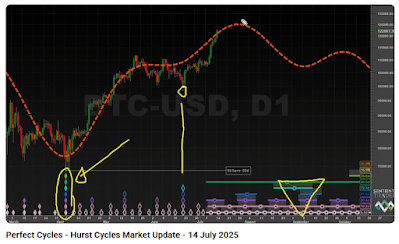Gold's price action has been challenging to analyze due to its recent flat trend, forming a wedge pattern. Gold is rising into an 80-day cycle peak, with potential for a higher price and a major 54-month cycle peak ahead.
Gold is currently rising into an 80-day cycle peak, and a higher price is expected in the near term.
Peak-Based Analysis (price peaks are synchronized): The current 54-month cycle peak is not sharply isolated, reducing confidence in its placement. A larger, sharper peak is expected, potentially displaced to the right, possibly reaching higher prices within the ongoing 80-day cycle peak.
Trough-Based Analysis (cycles align at troughs, which is mathematically incompatible with peak synchronization): The composite model (combining both analyses) shows divergence from the actual price, particularly recently, despite aligning at the 80-day cycle trough. This discrepancy suggests the major cycle peak is mispositioned, reinforcing the likelihood of a significant peak forming soon.
Close monitoring is needed due to the analysis discrepancy and non-ideal peak characteristics.
See also:
Gold (CMX) 40 Year Seasonality (1980-2019).
Gold likely remains in a broader bullish Elliott Wave structure, still supporting the expectation of a new all-time high. The preferred view
is that wave four ended at $3,123 and wave five has begun, or that gold is forming an ending diagonal, having completed wave one and now correcting in wave two. This would lead to a five-wave diagonal, typically marked by overlaps, ultimately reaching new highs in a less aggressive fashion. The alternate view is that gold
remains in an extended wave four correction. However, this is seen as
less likely due to the disproportionate time it would take compared to
previous subwaves, making it structurally inconsistent with typical
Elliott Wave proportions.
Elliott Wave structure favors another all-time high around $3,600 depending on how Wave 5 unfolds [see the above mentioned major 54-month Hurst cycle peak].
Support at $3,123 and especially $2,970 remains critical. Staying above these levels keeps the bullish case intact. A decisive break below $2,970 with increased downside momentum would raise the likelihood that gold has topped. The structure still favors another all-time high, with a potential target around $3,600. Unless $2,970 breaks with conviction, the market bias remains upward, with summer consolidation expected to resolve higher into the fall and year-end.
Following the completion of Wave 5, gold is expected to undergo a longer-term, multi-year retracement—either to around $2,541, or more significantly, by 61.8% to 78.6%, potentially reaching levels near $1,379.50 or even $884.20.






































